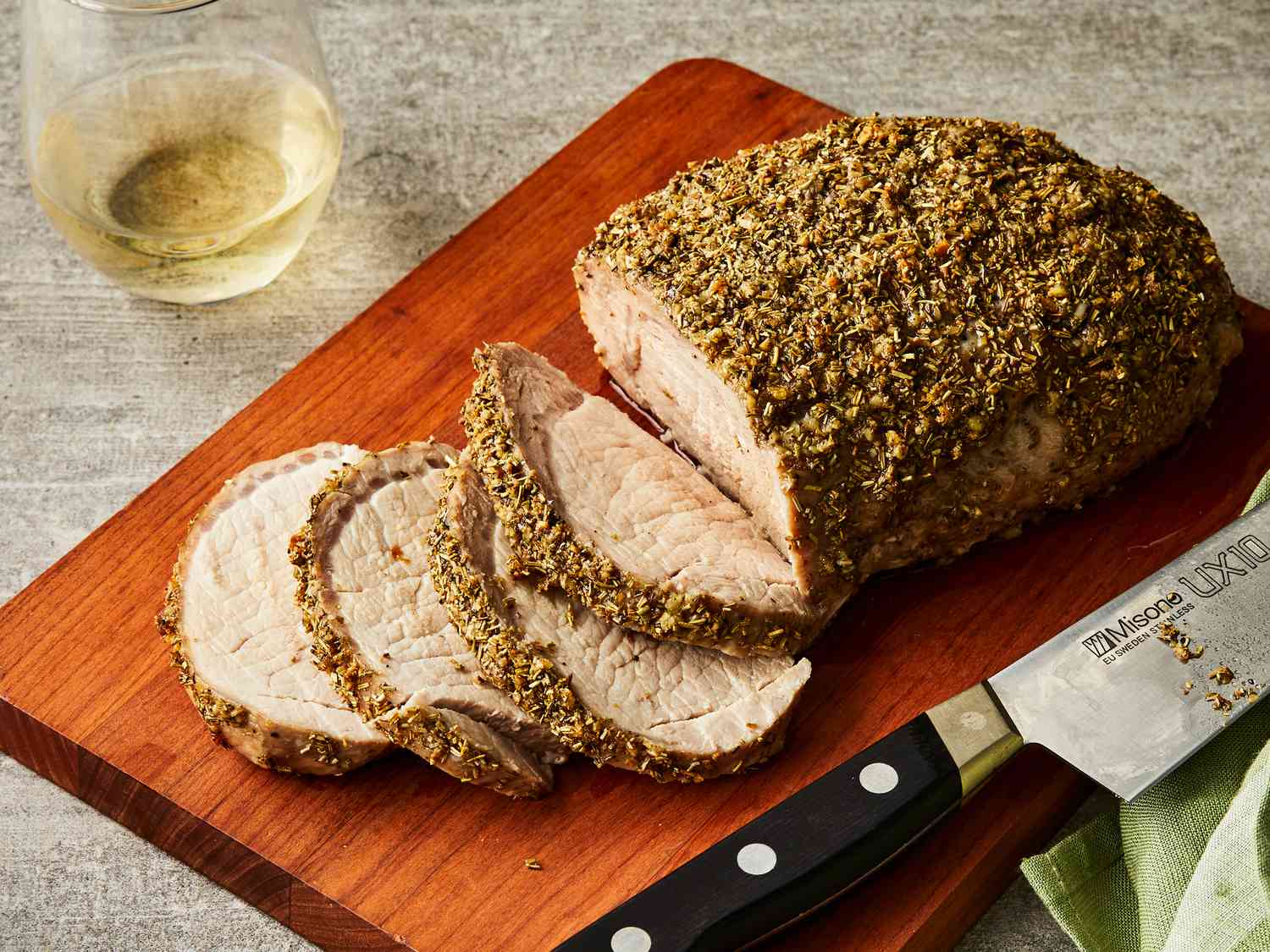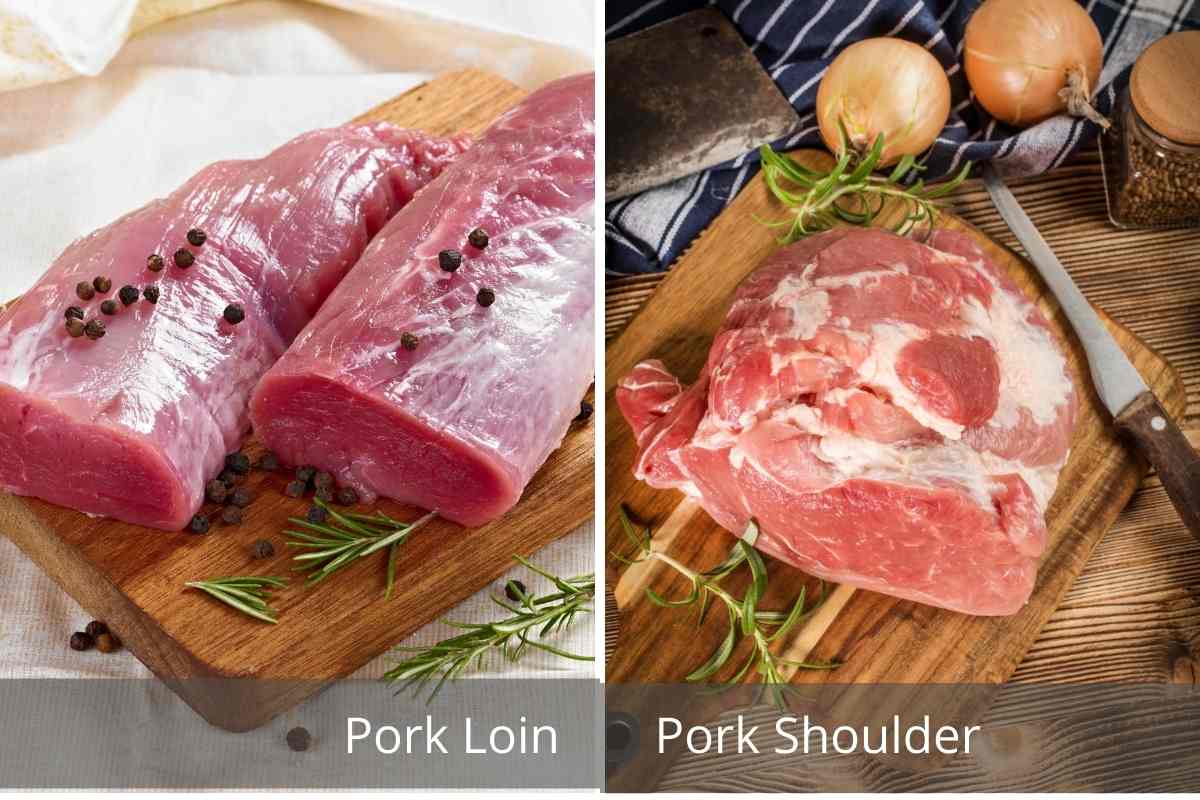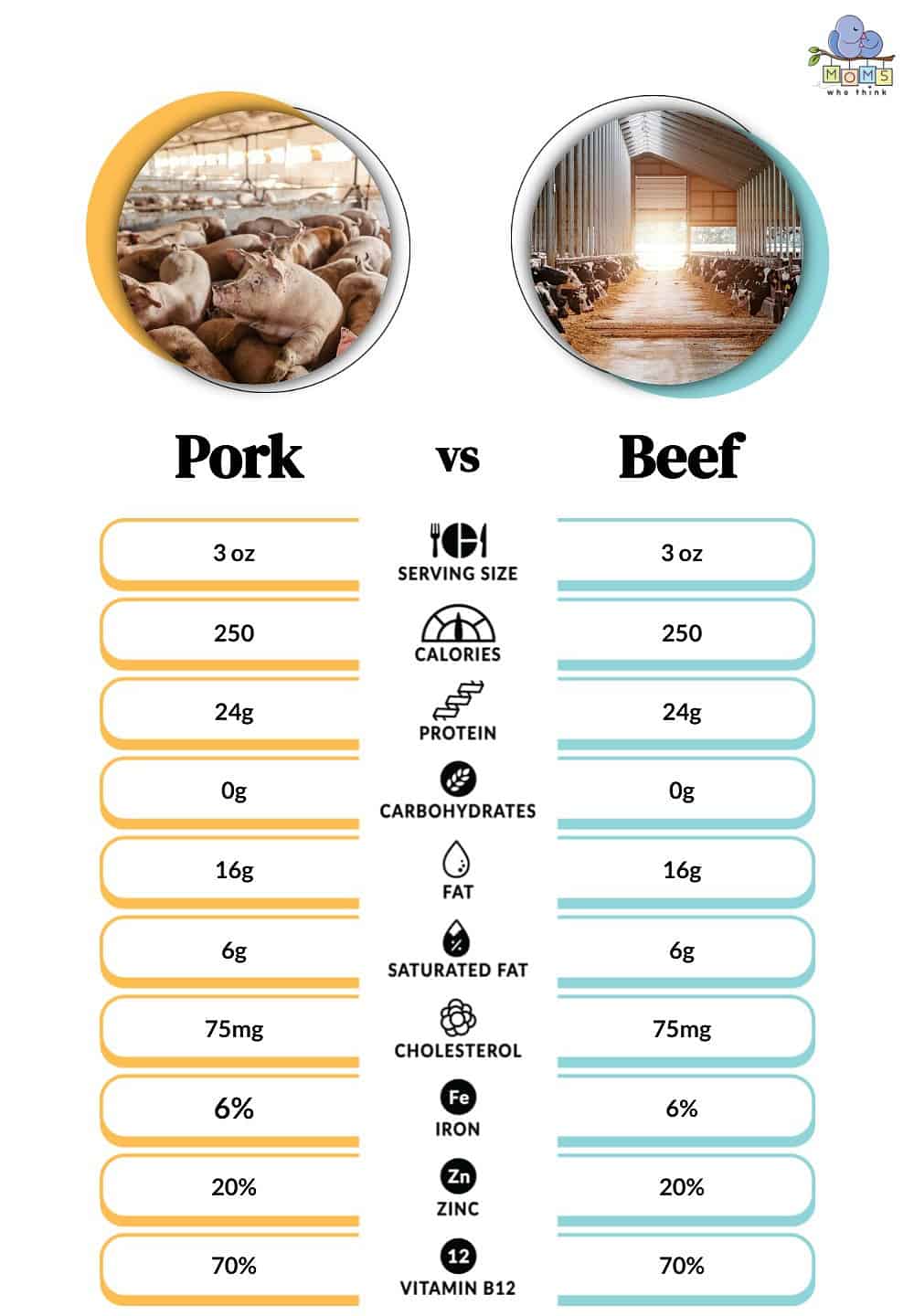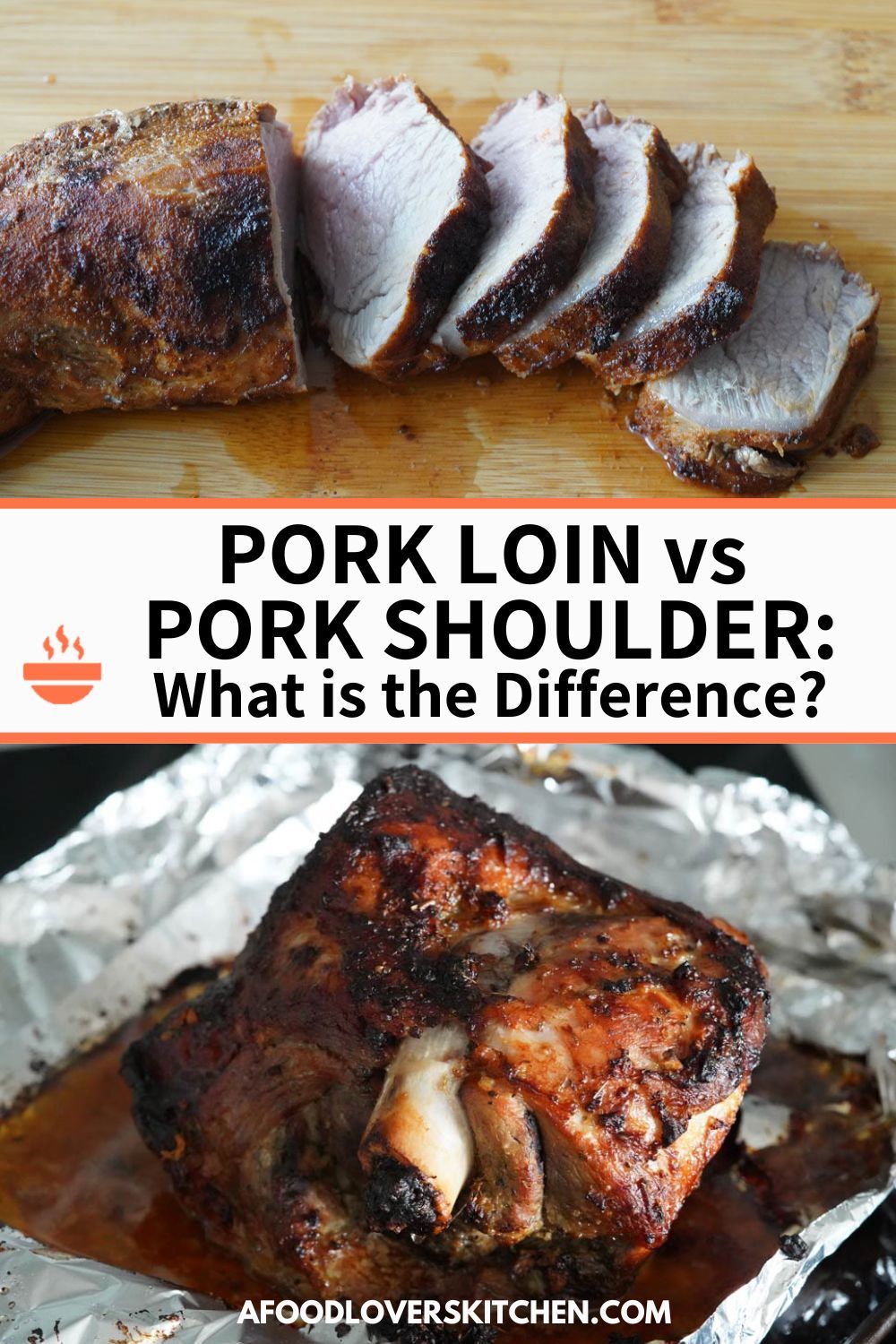Understanding Pork Loin And Pork Shoulder

Pork loin and pork shoulder are two distinct cuts of meat with different characteristics and ideal cooking methods. Pork loin is a lean and tender cut that is typically obtained from the back of the pig. It has a mild flavor and is best suited for recipes that require a quick cooking time, such as grilling or pan-frying. On the other hand, pork shoulder comes from the front of the pig and has a higher fat content. It has a rich and flavorful taste and is best cooked using low and slow methods, such as roasting or braising, to ensure its tenderness.
Pork Loin: Cut, Characteristics, And Ideal Cooking Methods
The pork loin is a lean and tender cut that is usually obtained from the back of the pig. It is characterized by its mild flavor and juicy texture. This cut is versatile and can be used in various recipes. The ideal cooking methods for pork loin include grilling, pan-frying, or roasting, as these methods help preserve its tenderness and enhance its natural flavors. Popular dishes that can be made with pork loin include pork chops, tenderloin medallions, and pork stir-fry. Its lean nature makes it a healthy option for those looking for a delicious and nutritious meal.
Pork Shoulder: Overview, Texture, And Best Uses In Cooking
The pork shoulder, also known as pork butt or Boston butt, is a versatile cut that comes from the upper part of the pig’s shoulder. It has a higher fat content and a marbled texture, which makes it ideal for slow cooking methods like braising, roasting, and smoking. This cut is known for its rich flavor and tender, juicy meat. It can be used to make pulled pork, carnitas, and stews, as well as being a popular choice for barbecue. The longer cooking time allows the fat to render, resulting in melt-in-your-mouth goodness.
Flavor Profile And Texture

When it comes to flavor profile and texture, pork loin and pork shoulder have distinct characteristics. The pork loin, being a lean cut, has a mild taste and tender texture. It is known for its fine grain and is often described as juicy and tender when cooked properly. On the other hand, pork shoulder has a richer flavor due to its higher fat content. It has a marbled texture that becomes melt-in-your-mouth delicious when slow-cooked, resulting in succulent and moist meat. These differences in flavor and texture make each cut suitable for different culinary applications.
Pork Loin: Taste And Tenderness Analysis
Pork loin offers a mild and delicate taste that appeals to a wide range of palates. Its lean nature contributes to a tender texture, making it a preferred choice for dishes where tenderness is a priority. The fine grain of pork loin ensures a juicy and succulent eating experience when cooked correctly, whether roasted, grilled, or pan-seared. With its tender and moist qualities, pork loin is versatile in flavor profiles. It readily absorbs marinades, seasonings, and spices, allowing for endless culinary possibilities. Whether it’s a classic herb-roasted pork loin or a tangy BBQ-glazed creation, the taste and tenderness of pork loin remain consistently impressive.
Pork Shoulder: Flavor Profile And Succulence Comparison
Pork shoulder offers a rich and intense flavor profile that is highly prized in many cuisines. Its higher fat content adds depth and richness to dishes, making it a popular choice for slow-cooking methods such as braising or roasting. The marbling of fat within the meat gives it a succulent and juicy texture, resulting in melt-in-your-mouth tenderness. From pulled pork sandwiches to hearty stews, pork shoulder’s succulence and robust flavor make it a favorite for creating bold and satisfying dishes.
Cooking Techniques

When it comes to cooking techniques, both pork loin and pork shoulder have their own unique requirements. Pork loin, being a lean cut, is best cooked using quick and high-heat methods such as grilling, pan-searing, or broiling. These methods help to maintain its tenderness and preserve its mild flavor. On the other hand, pork shoulder, with its higher fat content and tougher texture, benefits from slow-cooking techniques like braising or roasting. These methods break down the connective tissues and render the fat, resulting in tender and succulent meat. It’s important to choose the appropriate cooking technique based on the cut of pork to ensure optimal results.
Pork Loin Cooking Methods And Recipes
Pork loin can be prepared using various cooking methods that highlight its tenderness and mild flavor. Grilling is a popular choice, where the loin can be marinated and cooked over high heat for a delicious smoky flavor. Pan-searing is another great option, allowing for a crispy exterior while keeping the meat juicy and tender. For a quick and easy meal, pork loin can also be oven-roasted with fresh herbs and spices for a flavorful entree. Whether you’re craving a simple grilled pork loin or an elegant roasted dish, there are plenty of recipes available to suit your taste preferences.
Pork Shoulder Preparation And Cooking Techniques
Pork shoulder requires special preparation and cooking techniques to fully showcase its tender, flavorful meat. Before cooking, the shoulder can be seasoned or marinated to enhance its taste. One popular preparation method is slow cooking or braising, which allows the tough connective tissues to break down and results in a succulent and tender dish. Another technique is smoking, which infuses the meat with a rich, smoky flavor. Additionally, the shoulder can be sliced and used in stews or pulled for sandwiches. It is important to cook pork shoulder slowly and at a low temperature to ensure a moist and delicious outcome.
Nutritional Value And Health Considerations

When comparing the nutritional value of pork loin and pork shoulder, both cuts offer similar nutrient profiles since they come from the same animal. However, there are some differences to note. Pork loin is a leaner cut, containing less fat and calories compared to pork shoulder. This makes pork loin a healthier choice for individuals looking to reduce their calorie and fat intake. It is important to note that the healthiness of these cuts depends on how they are cooked and served. Adding excessive fat or using high-fat cooking methods can significantly affect the overall nutrition content.
Nutrient Comparison: Pork Loin Vs. Pork Shoulder
When comparing the nutrient content of pork loin and pork shoulder, there are some notable differences. Pork loin is a leaner cut with less fat and calories compared to pork shoulder. On average, pork loin contains around 149 calories and 5 grams of fat per 3-ounce serving, while pork shoulder has approximately 213 calories and 11 grams of fat per serving. However, both cuts are excellent sources of protein and contain essential vitamins and minerals, such as B vitamins, zinc, and iron. It’s important to consider portion sizes and cooking methods to ensure a healthy consumption of these cuts.
Health Benefits And Concerns Of Consuming Pork Cuts
Consuming pork cuts, such as pork loin and pork shoulder, can provide several health benefits. Pork is a good source of protein, which is essential for building and repairing tissues in the body. It also contains important vitamins and minerals, including B vitamins, zinc, and iron. However, it is important to note that pork can also be high in fat, particularly in cuts like pork shoulder. Excessive consumption of fatty pork cuts may increase the risk of heart disease and other health conditions. It is advisable to choose leaner cuts and practice moderation for a healthy diet.
Culinary Uses And Recommendations

Culinary Uses and Recommendations: Both pork loin and pork shoulder have their own unique culinary applications. Pork loin, with its tender and lean meat, is perfect for dishes that require quick cooking, such as grilling, roasting, or pan-frying. It can be marinated or seasoned with bold flavors for a delicious and juicy result. On the other hand, pork shoulder, with its rich marbling and connective tissue, is ideal for slow cooking methods like braising or roasting. It becomes incredibly tender and flavorful after long hours of cooking, making it perfect for pulled pork, stews, and roasts.
Recommended Dishes Using Pork Loin
Pork loin is a versatile cut that lends itself well to a variety of delicious dishes. One popular option is to simply season it with herbs and spices, then roast it to perfection in the oven. Another tasty choice is to slice the loin into medallions and sauté them with a flavorful sauce, such as a creamy mushroom or tangy mustard sauce. For a lighter option, thinly slice the pork loin and use it in stir-fries or salads. Its tender and juicy texture makes it a great choice for sandwiches or wraps as well.
Culinary Applications Of Pork Shoulder In Different Cuisines
Pork shoulder is a versatile cut that is widely used in various cuisines around the world. In Mexican cuisine, it is commonly used to make succulent and flavorful carnitas, which are tender and juicy slow-cooked pork pieces. In Asian cuisine, pork shoulder is often used in dishes like Chinese BBQ pork (Char Siu) and Filipino Adobo. In American barbecue, pork shoulder is the star ingredient for pulled pork, a smoky and tender dish. Whether braised, roasted, or grilled, pork shoulder adds richness and depth to dishes in different cuisines. Its versatility makes it a favorite choice for many chefs and home cooks alike.
Conclusion

In conclusion, the comparison between pork loin and pork shoulder reveals distinct characteristics and uses for each cut. Pork loin is a lean and tender cut, ideal for quick cooking methods and dishes that require a milder flavor. On the other hand, pork shoulder offers a more robust flavor and succulence, making it the go-to choice for slow-cooked dishes. The decision between pork loin and pork shoulder ultimately depends on the desired texture, flavor, and cooking time. Understanding the differences between these cuts can help chefs and home cooks select the perfect pork cut for their culinary creations.
Summary Of Differences Between Pork Loin And Pork Shoulder
Pork loin and pork shoulder are two distinct cuts of meat with notable differences. Pork loin is a lean and tender cut that is best suited for quick cooking methods. It has a mild flavor and is often used in recipes that require a shorter cooking time. On the other hand, pork shoulder is a more fatty and flavorful cut that is ideal for slow cooking. It is known for its succulence and is commonly used in dishes that benefit from long, slow simmering. Understanding these differences allows for appropriate selection and preparation based on desired cooking techniques and flavors.
Tips For Choosing The Right Pork Cut For Your Cooking Needs
When it comes to choosing the right pork cut for your cooking needs, there are a few factors to consider. First, determine the cooking method you plan to use. If you’re looking for a quick and lean option, go for pork loin. If you’re aiming for a flavorful and tender result, opt for pork shoulder. Consider the recipe you’ll be using and whether it requires a shorter or longer cooking time. Additionally, don’t be afraid to ask your butcher for recommendations based on your preferences and cooking goals. Overall, understanding the differences between pork loin and pork shoulder will help you make the best choice for your culinary endeavors.
FAQ About Pork Loin Vs Pork Shoulder: Comparing Pork Cuts
Q: What is the main difference between pork loin and pork shoulder?
A: The main difference lies in the location of the cut on the pig. Pork loin is taken from the back of the pig and is leaner, while pork shoulder comes from the front shoulder area and has more fat marbling.
Q: How does the tenderness differ between pork loin and pork shoulder?
A: Pork loin is known for being tender and is ideal for quick cooking methods like grilling or roasting. On the other hand, pork shoulder is a tougher cut that benefits from slow cooking methods like braising or slow roasting to break down the collagen and connective tissues.
Q: Which cut is better for specific dishes?
A: Pork loin is great for dishes where you want a lean and tender texture, such as pork chops or a tenderloin roast. Pork shoulder is ideal for dishes that require longer cooking times and benefit from the rich flavor and juiciness that the marbling provides, like pulled pork or stews.
Q: Is there a significant price difference between pork loin and pork shoulder?
A: Yes, there is usually a price difference between the two cuts. Pork loin tends to be more expensive due to its leaner nature and versatility in cooking methods. Pork shoulder is often more budget-friendly and is a popular choice for slow-cooked meals.
Q: Can pork loin and pork shoulder be substituted for each other in recipes?
A: While both cuts come from the same animal, they have different textures and flavors. It’s best to use them as specified in recipes to achieve the desired outcome. However, in certain dishes where the cut is braised or slow-cooked, you may be able to substitute one for the other with some adjustments in cooking time and method.
Q: How should pork loin and pork shoulder be stored and handled to ensure freshness?
A: Both cuts should be stored in the refrigerator at or below 40°F (4°C) to prevent bacterial growth. To maintain freshness, store pork loin and pork shoulder in airtight containers or tightly wrapped in plastic wrap. Make sure to use them within a few days or freeze them for longer storage.

Stutts House of Barbecue is a haven for BBQ enthusiasts, offering a delectable array of smoked delicacies, including ribs, beef, bologna, and chicken, accompanied by all the trimmings you could ever dream of. Our passion for perfecting the art of smoking meats shines through in every savoury bite. At Stutts House of Barbecue, we take pride in our custom smoking techniques, ensuring that each piece of meat is infused with the perfect blend of smoky flavours. But it doesn’t stop there – our homemade desserts are the cherry on top of a delicious meal, adding a sweet finish to your BBQ experience.